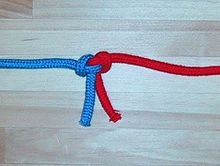|
Butterfly bend
The butterfly bend is a knot used to join the ends of two ropes together. It is the analogous bend form of the butterfly loop,[1] in that it is the butterfly loop with the loop cut.[2] The observation that the butterfly loop is secure enough to isolate a worn or damaged section of rope within the loop indicated that the bend form of the knot would be similarly secure.[3] HistoryWhen Phil D. Smith made the first known presentation of the Hunter's bend in 1953 (under the name "rigger's bend"),[4] he described it as a modification to the butterfly bend.[3] While the bend form had been known to mountaineers, nautical rigger Brion Toss brought the knot to a wider audience when he published it in 1975. Unaware of the earlier publication, Toss called the butterfly bend the strait bend after the Strait of Juan de Fuca.[1][5] TyingThe butterfly bend can be tied using a subset of the methods used for tying the loop form by holding the two rope ends together and treating them as if they were a single bight. However, specific methods have been developed for tying the bend form directly, including the one shown below and characterizable using the mnemonic device "A d through a b; 'twixt the two and toward me":  SecurityA properly tied butterfly bend should be as secure as the equivalent loop form.[1] However, subtle positioning errors during the above shown tying method can result in a similar looking but insecure bend knot.[6] See alsoReferences
|
||||||||||||||||
